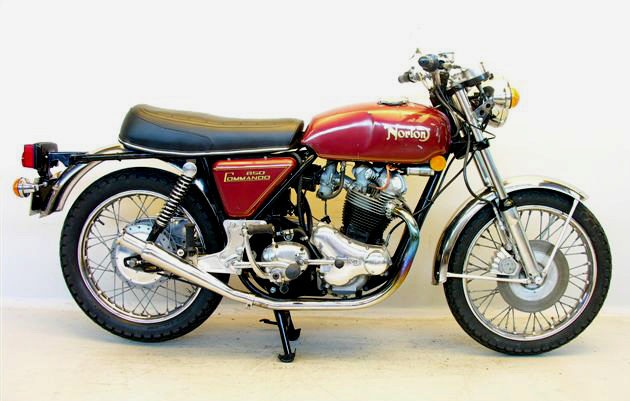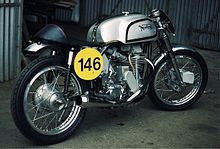
The Norton Motorcycle Company (formerly Norton Motors, Ltd.) is a British motorcycle marque, originally from Birmingham, UK. It was founded in 1898 as a manufacturer of "fittings and parts for the two-wheel trade". By 1902, the company began manufacturing motorcycles with bought-in engines. In 1908, a Norton-built engine was added to the range. This began a long series of production of single and eventually twin-cylinder motorcycles, and a long history of racing involvement.
When major shareholders started to leave Norton in 1953, the company declined and Associated Motor Cycles bought the shares. Although motorcycle sales went through a recession in the 1950s, and Norton Motors Ltd was only a small manufacturer, Norton sales flourished. A series of Norton Dominator Twins of 500cc, then 600cc, then 650cc and then the 750cc Norton Atlas kept sales buoyant, especially with sales to the USA.
In 1968, the new 750cc Norton Commando Model appeared, with the engine/gearbox/swingarm unit "isolastically" insulated from the frame with a series of rubber mountings. This kept the vibrations from the rider, giving a smooth comfortable ride. The Commando was a best seller, and voted #1 Motorcycle of the Year a number of times in Britain. 850cc Models appeared for 1973, giving more torque. For 1975 an electric start arrived in the 850 Mk3.
In late 2008, Stuart Garner, a UK businessman, bought the rights to Norton from some US concerns and relaunched Norton in its Midlands home at Donington Park where it will develop the 961cc Norton Commando, and a new range of Norton motorcycles.
After the Second World War, Norton reverted to civilian motorcycle production, gradually increasing its range. A major addition in 1949 was the twin cylinder Model 7, known as the Norton Dominator, a pushrod 500 cc twin-cylinder machine designed by Bert Hopwood. Its chassis was derived from the ES2 single, with telescopic front and plunger rear suspension, and an updated version of the gearbox known as the "lay-down" box. More shapely mudguards and tanks completed the more modern styling to Nortons new premium model twin.

Norton struggled to reclaim its pre-WWII racing dominance as the single-cylinder machine faced fierce competition from the multi-cylinder Italian machines and AJS from the UK. In the 1949 Grand Prix motorcycle racing season, the first year of the world championship, Norton made only fifth place and AJS won. That was before the Featherbed frame appeared, developed for Norton by the McCandless brothers of Belfast in January 1950, used in the legendary Manx Norton and raced by riders including Geoff Duke, John Surtees and Derek Minter. Very quickly the featherbed frame, a design that allowed the construction of a motorcycle with good mass-stiffness distribution,became a benchmark by which all other frames were judged.
Norton also experimented with engine placement, and discovered that moving the engine slightly up/down, forward/back, or even right/left, could deliver a "sweet spot" in terms of handling. Motorcycle designers still use this method to fine-tune motorcycle handling.
In 1951, the Norton Dominator was made available to export markets as the Model 88 with the Featherbed frame. Later, as production of this frame increased, it became a regular production model, and was made in variants for other models, including the OHV single-cylinder machines.
Manx Nortons also played a significant role in the development of post war car racing. At the end of 1950, the English national 500 cc regulations were adopted as the new Formula 3. The JAP Speedway engine had dominated the category initially but the Manx was capable of producing significantly more power and became the engine of choice. Many complete motorcycles were bought in order to strip the engine for 500 cc car racing, as Norton would not sell separate engines.
The racing successes were transferred to the street through cafe racers, some of which would use the featherbed frame with an engine from another manufacturer to make a hybrid machine with the best of both worlds. The most famous of these were Tritons- Triumph twin engines in a Norton featherbed frame.
MANX NORTON
The Norton Manx or Manx Norton is a British racing motorcycle that was made from 1947 to 1962 by Norton Motors Ltd. A Norton had contested every Isle of Man TT race from the inaugural 1907 event through into the 1970s, a feat unrivalled by any other manufacturer, and the development and honing of the Manx racing motorcycle was another step in this racing achievement.
New Manx Nortons, built to various specifications are still available to buy new, from various suppliers around the world. These suit different categories and definitions of Classic Motorcycle Racing and Historic Motorcycle Racing in different countries around the world.
Norton's first use of the name 'Manx' was applied to the 'Manx Grand Prix' model available from 1936-1940, a special racing version of their 'International' roadster, with telescopic forks and a plunger rear suspension, magnesium for the crankcases and cambox, and no provision for lighting. Just after WW2, the 'Grand Prix' was dropped, and Norton named their 1947 racing model the 'Manx'. It was a lightly redesigned prewar racing Norton International, an overhead cam single-cylinder machine available as a 350cc or 500cc. The Norton factory race bikes under team manager Joe Craig were experimental models, and a version was available to buy from the factory in Bracebridge Street - to selected customers. Fitted with the McCandless brothers Featherbed frame for 1950, the Manx gained a new lease of racing life as a racing machine, the new frame giving the fine steering necessary for high speed navigation of some very fast racing circuits of the time.
The last Bracebridge Street (the original home of Norton) Manx Nortons were sold in 1963. Even though Norton had pulled out of International Grand Prix racing in 1954, the Manx had become the backbone of privateer racing.The Classic Motorcycle Racing movement from the 1970s onwards has seen relatively large numbers of Manxs return to the track, and a flourishing supply of parts and services has appeared all around the world to nourish this demand.
The Norton Manx was developed to win the Isle of Man TT from single overhead cam international racers by Norton racing team engineer Joe Craig. The double overhead cam configuration was developed in 1937 and after many problems perfected one year later. The Manx was delayed by the outbreak ofWorld War II but re-emerged for the 1946 Manx Grand Prix. The motorcycle was upgraded with new telescopic forks and in 1948 gained twin leading shoe brakes. In 1950 the innovative featherbed frame was developed, giving the Manx a significant competitive advantage through a low centre of gravity and short wheelbase that was perfectly suited the challenging island TT course. The all-welded, tubular featherbed frame was light and trim, without the usual forgings that added unnecessary weight. In 1950, the featherbed Manx recorded a double hat-trick of podium positions at the TT.The Manx engine was redesigned in 1953 with a much shorter stroke of 86.0 mm × 85.6 mm (3.39 in × 3.37 in) to improve the rev range.

The major 1954 upgrade to the Manx was to have been an engine with the cylinder mounted horizontally to give a much lower centre of gravity – along the lines of the Moto Guzzi and Benelli racers. However, a decline in sales in the mid 1950s prompted a number of manufacturers to withdraw from GP racing in 1954, and Nortons did likewise. The Norton F Type Manx, as it was to have been, still exists, and restored is displayed in the Sammy Millers Museum Collection.With Nortons withdrawal from racing, Joe Craig retired after more than 25 years of coaxing ever more power and reliability from his single cylinder Cammy racers.